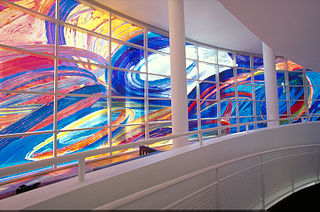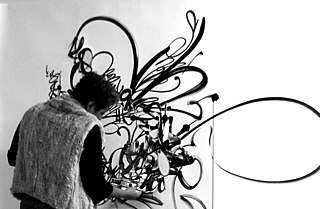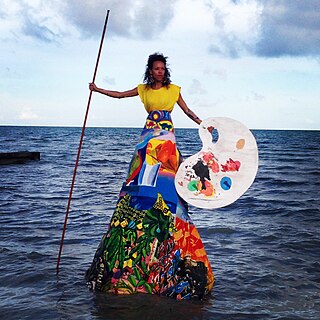Work

Moon makes both painting and ceramic vessels. She describes her paintings as cultural landscapes, where her ceramic sculptures act more as hybrid portraits. [3] Moon has spent roughly half of her life in Korea, where she was born, and half in the United States; the feeling of not fully belonging in either culture is one that drives much of the imagery and iconography within her work. [6]
"I feel like my life is like a collage, and I’m a piece of it. I cut and pasted myself from Korea to America. I use tradition as a point of departure, but I don’t want my work to be about an idea. I want it to become something completely new. Tradition is history set in place, but culture is always shifting. I like to juxtapose these two to create a dialogue. I want them to be harmonized as well as individually recognized. " [7]
Moon's paintings combine visual icons and symbols from a variety of sources, cutting across culture lines to the accumulation of art historical, corporate, and advertising symbols in contemporary society. Eastern and Western imagery and painting techniques, emoji, internet icons, and folk art are present in her work. She is particularly interested in the ways cultural signifiers are interpreted differently by different viewers. For example, peaches are a common iconography in Georgia, where Moon lived; peaches are also an important symbol across Asian manuscript paintings and folk art, as a symbol of chasing bad spirits away. Moon enjoys using iconographies like the peach in her work, because they carry dual notions. [8] She works primarily in acrylic paint on Hanji, a Korean paper, which she uses to help "keep [her] identity in [her] studio practice." [8] She also incorporates fabrics, embroidery, and print collage in her paintings. After she completes the abstract version of a painting's composition, she re-configures or strategically defines some of the markings to suggest recognizable images, such as cartoon characters. She also incorporates mass-produced items like textiles, embroidered patches, small trinkets. [9]
Art critic Roberta Smith wrote about Moon's work in the 2005 Asia Society exhibition "One Way or Another: Asian American Art Now," stating, "Jiha Moon packs...information into large, teeming paintings on paper, creating a sense of flux... rife with references to everything from traditional Chinese brush painting to contemporary cartoons." [10]
Moon describes 19th century Joseon dynasty white porcelain as the first type of ceramics that captured her attention. She is especially drawn to the type of moon jars with lots of drawing on their surfaces, loving what she calls the "more human, imperfect, and humorous quality" of these vessels. [3] Moon's own ceramic journey began with an award from MOCA GA in 2012; with the support she received, she paid a membership to a local clay studio and began to explore ceramics. [5] One recurring theme in her ceramic work is the fortune cookie. Moon sees the cookie as a portrait of America, a symbol of the country's function as a melting pot; people assume the cookie has Chinese or Asian origins, when in fact it is an American invention. Moon often will use the cookie shape in the place of eyes or ears on her ceramic vessel, and she enjoys how easily it can be camouflaged within the work; "People do not see it immediately unless they pay attention. When they recognize it is a fortune cookie, they re-engage, go back and look at it again." [5]
She has received a number of awards including the Joan Mitchell Foundation Painters and Sculptors Grant, [11] the Trawick Prize, [12] and a Museum of Contemporary Art of Georgia Working Artist grant. Moon has been an artist in residence at the Headlands Center for the Arts, the Omi International Arts Center, MacDowell Colony, the Fabric Workshop and Museum, and the Henry Luce III Center for the Arts and Religion.
Her work, Yellowave (black) 1, was acquired by the Smithsonian American Art Museum as part of the Renwick Gallery's 50th Anniversary Campaign. [13] [14]
Moon was awarded a Guggenheim Fellowship in the Fine Arts in 2023. [15]











